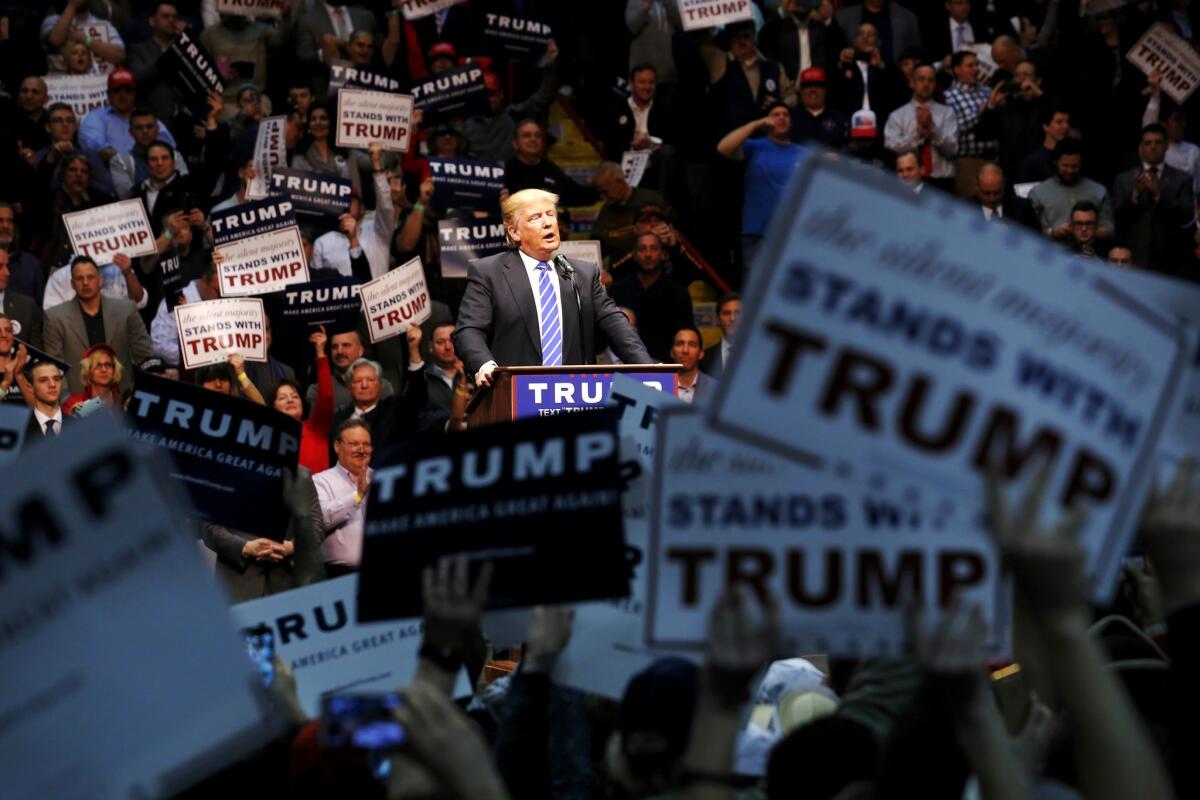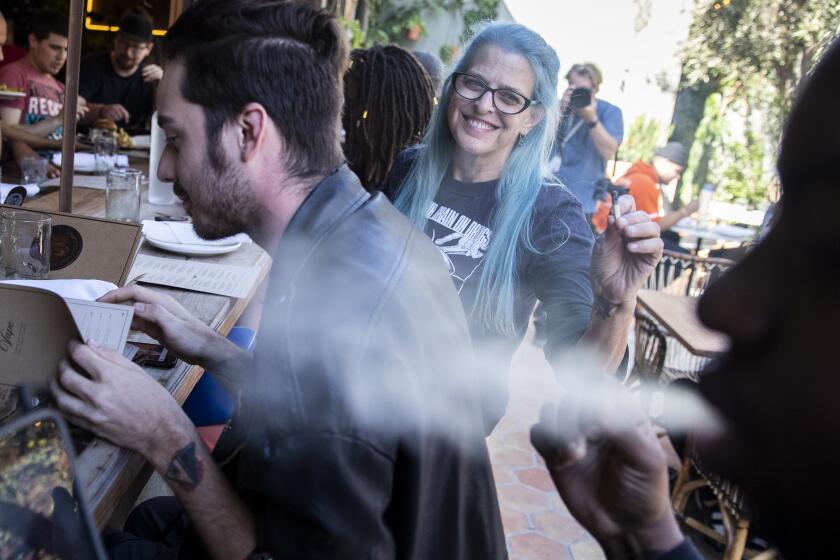Analysis: In New York, presidential candidates are alone in their own comfortable bubbles

A campaign rally Monday for Donald Trump in Albany, N.Y.
Reporting from New York — Hundreds of thousands of words have been uttered by candidates in pursuit of the nearly 400 delegates at stake in New York’s primary next Tuesday. And those words have made one thing very clear: the candidates spend most of their time in bubbles.
Republicans talk a certain way about a certain set of topics. Democrats talk another way about another set of topics. Rarely do the words or subjects intersect, and when they do, it’s nowhere near the middle.
That may distress the majority of Americans who consistently tell pollsters they want politicians to work together and get things done. But it is driven by another political reality: Democrats have moved to the left and Republicans to the right, leaving fewer people in the ideological middle and setting a clear path for any presidential candidate who wants to succeed.
Three candidates — Donald Trump, Ted Cruz and Bernie Sanders — have freely resided on the edges of the political spectrum. They have been rewarded by the passion of voters who live there.
Hillary Clinton and John Kasich — more centrist, if only by comparison — have made more overt appeals for bipartisan cooperation. In theory, that would heighten their ability to draw support in a general election, particularly among the remaining moderate voters.
But in the primary season, that posture has made Kasich’s road to the nomination more rocky. And it has helped to extend the length of the Democratic primary battle, even though Clinton remains ahead and appears to hold a comfortable lead here in New York where the next balloting takes place on Tuesday.
Indeed, middle-of-the-road behavior has been used as a cudgel this campaign year.
Sanders, the Vermont senator, routinely derides Clinton’s positions as less liberal than they should be on issues such as Wall Street’s fate, college tuition, campaign financing, healthcare and minimum wage increases.
On Sunday at Coney Island, Sanders also offered an telling description of the left-Democratic bubble. His subject was the recent move in California and New York to raise the minimum wage to $15 per hour. He credited the achievement to union strikes and protests.
“They rallied the American people and millions of people began to agree with them,” he said. “And then a few years ago in Seattle, 15 bucks an hour. Los Angeles. San Francisco, 15 bucks an hour. Oregon, 15 bucks an hour, California. And with millions of people standing up and fighting back in New York, 15 bucks an hour.”
All of those places are so sharply Democratic that their political conversations take place between the left and the far left. There is no comparable competitive state, let alone a right-leaning one, that has moved to dramatically increase the minimum wage.
In the Republican bubble, Texas Sen. Cruz has as a campaign staple his pledge to protect gun rights, even if most Americans favor some new restrictions. He talks of his opposition to abortion rights even in cases of rape or incest. He sought to shut down the government in order to deny Planned Parenthood any federal money. Both positions are opposed by a majority of Americans, but increasingly favored by the conservative Republicans on whom Cruz’s political future depends.
As he declared victory after last week’s Wisconsin primary, Cruz called for “a Supreme Court that protects their religious liberty. The fundamental freedom of every one of us to live according to our faith and our conscience” — words that seemed to call for narrowing the court’s decisions on same-sex marriage and President Obama’s healthcare plan, both vehemently opposed by his voters.
“We’ll see a Supreme Court that protects the 2nd Amendment right to keep and bear arms,” he added to applause, “and our fundamental right to protect our families and our homes and our children.”
Trump took off after Clinton this week in words that drew applause in his bubble but shock outside it.
“Everybody knows that she is guilty as hell, okay? Everybody,” the New York businessman said of Clinton’s use of private email while secretary of State. “Her whole life has been a big, fat, beautiful lie. It’s been a terrible lie. Everything about her is a lie.”
That view is hardly universal; Clinton remains a largely popular front-runner among Democrats despite the lengthy primary fight, and easily defeats Trump in general election matchups.
There is no doubt that America has cleaved more extensively in recent years. From 1994 to 2014, according to surveys by the nonpartisan Pew Research Center, the percentage of voters taking positions on issues that marked them as consistently liberal or conservative doubled to 21%. The share who don’t stick consistently with one side or the other shrank by 10 points, to 39%.
In another Pew measurement, the amount of overlap between followers of the two parties has shrunk dramatically. The percentage of Republicans to the right of the average Democrat moved from 64% to 92% in the 20-year span. The percentage of Democrats to the right of a typical Republican went from 70% to 94%. And it was not a benign swing: almost 3 in 10 Democrats, and more than one-third of Republicans, considered the other party “a threat to the national well-being.”
Republicans and Democrats hold sharply different positions on the scope of government, healthcare, immigration, abortion rights, gun control and other issues, agreeing in Pew’s polls only on protecting Social Security.
“Both conservatives and liberals are kind of cocooned, and I think they overestimate -- grossly overestimate -- how popular their own views are and therefore underestimate how important it is to compromise to get things done,” said James Campbell, a political scientist at the University at Buffalo, part of the state university system.
In many cases those views are reinforced by like-minded family members and friends, and ideological news sources, he noted.
“It distorts their views, distorts your idea about where your ideas are on the political spectrum,” he said.
It also can leave those voters suspicious of candidates who don’t completely inhabit the bubble.
Clinton is by all measurements a liberal candidate; her positions in this campaign include a college tuition plan for all but the wealthy, a proposal to expand the nation’s healthcare plan, extensive plans to revamp the criminal justice system and provide support and training for those leaving prison, equal pay for women and an increase in the federal minimum wage.
But compared to Sanders, who draws massive crowds to cheer his proposals, she can seem moderate or incremental — not the profile sought by many activists this tempestuous year.
The same sort of comparison hurts Kasich. The Ohio governor is, by any other year’s definition, intensely conservative. He rose in Congress as a budget-cutter, but his vigilance on budget matters pales next to Cruz’s attempts to shut down the government to achieve his goals. As governor, Kasich has worked to close abortion clinics and deny funding to Planned Parenthood, but his acceptance of the right to abortion for victims of incest and rape — the position held by previous Republican nominees — puts him to the left of Cruz.
Kasich and Clinton also talk openly about working with the opposite party to achieve common goals — something approaching heresy to dug-in voters of both parties. As first lady and U.S. senator from New York, Clinton boasts, she accomplished her goals by working with ideological opposites such as former Texas Rep. Tom DeLay.
In a Tuesday speech in Manhattan, Kasich offered a plea for similar comity.
“When we come together, when we unite as a country, America always wins,” he said. Following the more conservative “path of darkness” that he said was being trod by Cruz and Trump “can drive America down into a ditch.”
In past presidential contests, candidates moved as far to the edges as necessary to secure the nomination, knowing they would eventually sidle back toward the center to increase their odds of winning the general election. The question this year, particularly for Republicans whose top two candidates have staked out decidedly conservative positions, is whether anyone will feel the desire to make that shift.
Follow me on Twitter: @cathleendecker. For more on politics, go to latimes.com/decker.
ALSO:
Three candidates vie for bragging rights: Who’s the real new Yorker?
After exchanging harsh words last week, Clinton and Sanders get back on message
California’s politics, unlike New York’s, are mainly a TV affair
Live coverage from the campaign trail
More to Read
Get the L.A. Times Politics newsletter
Deeply reported insights into legislation, politics and policy from Sacramento, Washington and beyond. In your inbox three times per week.
You may occasionally receive promotional content from the Los Angeles Times.











